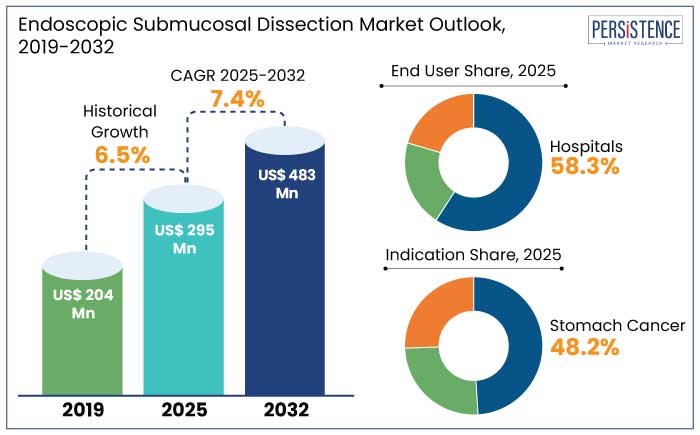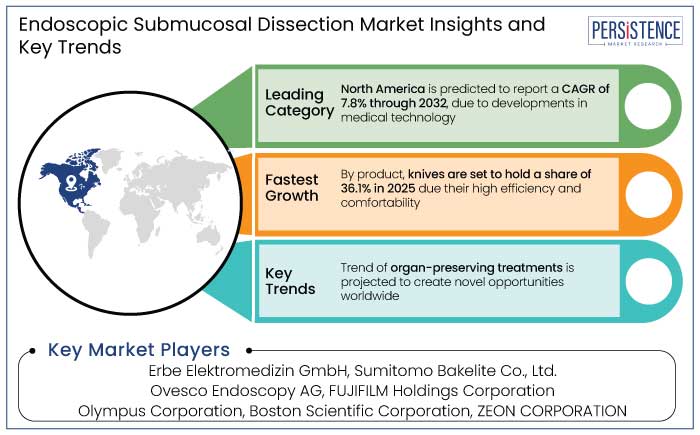Industry: Healthcare
Published Date: January-2025
Format: PPT*, PDF, EXCEL
Delivery Timelines: Contact Sales
Number of Pages: 183
Report ID: PMRREP22897
The global endoscopic submucosal dissection market is set to reach a size of US$ 295 Mn in 2025. It is predicted to rise at a CAGR of 7.4% through the assessment period to attain a value of US$ 483 Mn by 2032.
The surge in gastrointestinal problems and the need for less invasive treatments, especially for Barrett's esophagus and early-stage malignancies, are driving demand for Endoscopic Submucosal Dissection (ESD). According to the World Health Organization (WHO), gastrointestinal cancers, including colorectal and gastric cancers, account for over 3 million annual cases globally, underscoring the need for novel treatment solutions like ESD.
Technological developments have enhanced the precision and efficacy of ESD procedures. In April 2023, Olympus launched its ESD knife with enhanced cutting-edge technology, improving procedural accuracy and reducing complications.
Specialized training programs for gastroenterologists often emphasize early diagnosis and treatment and have the potential to revolutionize cancer care. These are especially gaining traction in developed economies and driving the global expansion of the ESD industry.

Key Highlights of the Market
|
Market Attributes |
Key Insights |
|
Endoscopic Submucosal Dissection Market Size (2025E) |
US$ 295 Mn |
|
Projected Market Value (2032F) |
US$ 483 Mn |
|
Global Market Growth Rate (CAGR 2025 to 2032) |
7.4% |
|
Historical Market Growth Rate (CAGR 2019 to 2023) |
6.5% |
In 2025, North America is set to dominate the global ESD industry with a market share of 41% and is projected to report a CAGR of 7.8% through 2032. The strong position is driven by well-established healthcare infrastructure, substantial healthcare expenditure, and rapid adoption of cutting-edge medical technologies. For instance,
The surging acceptability of ESD is reflected in its increasing inclusion in clinical practice guidelines in the West, such as the NCCN recommendations for superficial GI cancer. North America's market dominance is being enhanced by innovations like hybrid ESD knives as well as collaborations between manufacturers and healthcare institutions.
In 2025, Europe is likely to account for 26.4% of the global market share, with a projected CAGR of 6.9% through 2032. The market is driven by a favorable regulatory environment, ongoing technological innovations, and increased healthcare expenditure across the region.
Germany, France, and the U.K. are leading the adoption of ESD due to their established healthcare infrastructure and increasing prevalence of gastrointestinal cancers. For example,
Introduction of high-definition imaging systems for ESD by Europe’s healthcare providers and device makers is strengthening the region’s position in the ESD industry by enhancing treatment results and lowering complications.
In 2025, knives are projected to lead the global ESD industry with a 36.1% share, attributed to technological developments addressing complications and improving procedural efficiency. Scissor-like knives, known for their precision, control, and time-saving capabilities, have significantly influenced the adoption of ESD procedures in the West, particularly in the context of rising gastrointestinal disorders. For example,
The global adoption of novel ESD knives is anticipated to rise robustly due to growing demand for minimally invasive techniques and the rise in gastrointestinal cancer prevalence.
In 2025, hospitals are anticipated to hold 58.3% of the global ESD industry share, due to their unique infrastructure and the availability of novel medical equipment for complex procedures. Hospitals utilize new technologies like high-definition endoscopic systems, precision imaging, and state-of-the-art operating rooms for optimal patient care, collaborating with multidisciplinary teams for specialized treatment.
Hospitals' comprehensive healthcare services, including pre- and post-operative care, inpatient monitoring, and access to new therapies, enhance their appeal. AI-assisted endoscopic imaging, for instance, enhances diagnostic accuracy and procedural outcomes in hospitals, driving research and innovation, which is contributing to market growth.
The global endoscopic submucosal dissection market is witnessing growth due to the rising prevalence of gastrointestinal cancers and precancerous conditions. For instance,
ESD offers advantages over traditional surgery, such as reduced recovery time, lower complication rates, and organ preservation, making it increasingly preferred by patients and healthcare providers. The market is rising due to technological developments like Fujifilm's next-generation ESD device. Beyond gastric lesions, ESD is now being treated for colorectal and esophageal conditions.
The industry is further booming due to availability of insurance coverage, increased healthcare costs, and gastroenterologists' expertise. ESD has a bright future because of the aging population and increasing number of elderly people who are prone to gastrointestinal problems.

The global endoscopic dissection devices market recorded a CAGR of 6.5% in the historical period from 2019 to 2023. The usage of endoscopic procedures has increased due to the growth in gastrointestinal and colorectal illnesses.
It is anticipated that the incidence rate of colon cancer would increase globally, which will increase the number of patients and the need for endoscopic submucosal dissection devices. These operations are growing increasingly widespread even though they are uncommon in nations like the U.S., Brazil, Australia, and Germany.
Resection surgery may not be necessary when advanced lesions, such as early GI cancer, are removed by endoscopic submucosal dissection (ESD), a less invasive surgical technique.
In the endoscopic medical device industry, the FDA uses the 510(k) premarket approval procedure, which shortens the regulatory approval period and enables the FDA to concentrate on more important public health concerns. Demand for endoscopic submucosal devices is estimated to record a considerable CAGR of 7.4% during the forecast period between 2025 and 2032.
Surging Preference for Organ-preserving Treatments to Drive Demand
Demand for sophisticated endoscopic procedures like endoscopic submucosal dissection, which provide quicker recovery periods, fewer problems, and better patient quality of life, is driven by growing preference for organ-preserving therapies. For example,
Technological innovations like AI-assisted endoscopy systems and high-definition imaging have significantly enhanced the safety and efficacy of organ-preserving procedures. For instance,
Rising Prevalence of Stomach Cancer to Fuel Demand
Since stomach cancer is becoming more common and people are increasingly aware of the need for early diagnosis, the stomach cancer segment is anticipated to account for 48.2% of the worldwide ESD market in 2025. For example,
ESD, a minimally invasive method for early-stage gastric tumor removal, offers reduced pain, quicker recovery times, and lower complication rates compared to traditional surgery. After Japan recognized ESD as a standard treatment for early gastric cancer in 2014, it spread to other nations in Asia Pacific. New high-definition imaging systems introduced in March 2024 have enhanced precision and patient outcomes, solidifying ESD's role in managing stomach cancer.
Availability of Alternatives like Open Surgery to Create Hindrances
In order to prevent difficulties, more than 30 supervised stomach ESD treatments must be performed, which calls for certain technical abilities and committed training. Due to differences in mentor availability, pathology diagnosis, tools, and trainee experience, nations in the West are unable to use the training algorithms created by Japan for standardizing ESD training. The market's growth is constrained by high demand for qualified personnel, as well as potential opposition from other treatment alternatives such as open surgery and endoscopic mucosal excision.
Rising Research and Development Activities to Improve ESD Techniques
Research and development activities are playing a pivotal role in advancing ESD techniques and associated technologies, addressing challenges such as procedural complexity and adverse event risks. Endoscopic instruments, such as AI-based navigation systems, high-definition imaging systems, and cutting-edge traction devices, are being improved through investments. For instance,
Rising incidence of gastrointestinal cancers fuels demand for enhanced ESD solutions. The World Health Organization (WHO) highlighted in 2024 that gastrointestinal cancers account for 26% of global cancer diagnoses, underscoring the need for novel treatment options. Robotic-assisted ESD systems are being developed by healthcare practitioners and tech companies to improve early cancer diagnosis and treatment efficacy, safety, and accessibility.
Developments in ESD Traction Techniques Present Growth Potential
A surgical method for treating superficial gastrointestinal neoplasms that enables accurate tumor excision is ESD. Access issues, lengthier process times, and a higher risk of perforation make it technically challenging. Traction mechanisms that improve visibility and accuracy, such as hood traction, natural traction, and device-assisted traction, have been created to solve these issues. For instance,
AI-integrated endoscopic systems, launched in March 2024, improve real-time detection and dissection capabilities, reducing complications and improving outcomes in gastrointestinal cancer management. This is due to increasing awareness and adoption of minimally invasive techniques.
Leading companies in the endoscopic submucosal dissection market hold significant shares and dictate industry trends. They are prominent in the healthcare industry, with a loyal consumer base of hospitals, clinics, and laboratories.
Small companies also exist, catering to regional demands and relying on industry giants' innovations due to limited financial resources for research and development. These companies are extending their research and development activities to improve ESD techniques and technologies.
Recent Industry Developments
|
Attributes |
Details |
|
Forecast Period |
2025 to 2032 |
|
Historical Data Available for |
2019 to 2023 |
|
Market Analysis |
US$ Billion for Value |
|
Key Regions Covered |
|
|
Key Market Segments Covered |
|
|
Key Companies Profiled in the Report |
|
|
Report Coverage |
|
|
Customization and Pricing |
Available upon request |
By Product
By Indication
By End User
By Region
To know more about delivery timeline for this report Contact Sales

The market size is set to reach US$ 483 Mn by 2032.
Endoscopic submucosal dissection is a successful procedure, with studies showing that tumors only grow back in 1% of those who undergo it.
In 2025, North America is projected to generate a market share of 41%.
In 2025, the market is set to be valued at US$ 295 Mn.
Erbe Elektromedizin GmbH, Sumitomo Bakelite Co., Ltd., Ovesco Endoscopy AG, FUJIFILM Holdings Corporation, and Olympus Corporation are a few key players.